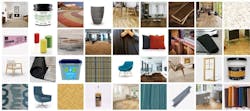Keeping in Mind IAQ Design and Build Fundamentals in a COVID-centric World
All it takes is a sneeze. Whether you’re working at home or in an office, that simple sound triggers a response. For most people, it goes something like this: “Hmm, maybe it’s just a winter allergy. No, that sounded more like a cold. What if there’s a fever? How do I know if it’s the flu or COVID-19? How do I know those germs aren’t spreading through the HVAC system?”
For architects, designers and contractors engaged in new construction, renovation and redesign projects, “healthy buildings” have taken on a whole new meaning in the age of COVID. Addressing occupant health, comfort and wellness looks different now as work and life continue to be impacted by the pandemic. The need for social distancing and physical barriers is challenging building professionals to rethink commercial, retail and industrial facility spaces.
Fortunately, there are multiple rating systems and certifications already available to help guide the design and construction of buildings that support occupant health, whether during a pandemic or not.
Navigating the World of Standards
For example, the WELL Building Standard focuses on designing spaces where occupants can thrive. Both the U.S. Green Building Council’s Leadership in Environmental and Energy Design (LEED v4.1) initiative and the European-based BREEAM sustainability assessment system actively encourage material transparency, indoor environmental quality and use of healthy building materials (e.g., the LEED v4.1 MR credit for Building Product Disclosure and Optimization–Material Ingredients).
Additionally, product certifications, such as SCS Global Service’s Indoor Advantage and the Resilient Floor Covering Institute’s FloorScore program, provide detailed requirements for a wide range of building materials, paints and coatings, furniture, and flooring products, which in turn lead to eligibility for recognition under a multitude of green building platforms.
The Health Product Declaration (HPD) Collaborative helps drive product transparency with its third-party verified HPDs, which can be used to meet LEED v4.1 MR credits, and contribute to other rating systems such as WELL, Healthy Hospitals, Google’s Healthy Building Program and the Living Product Challenge for Net Positive Material Health Imperative. The International Living Future Institute’s (ILFI) Living Building Challenge includes the use of healthy materials among its key criteria for eligibility in the Declare labeling database. ISO 16814:2008 and ISO 16000-40 delineate international indoor air quality standards. And the list goes on.
[Related Podcast: The Role of Net Positive Carpet and Flooring in the COVID Era]
Occupant Benefits
Underlying these green building standards, which provide a platform upon which to plan and build, are the proven health benefits to the occupants who will live and work in these spaces. For example, a seminal study conducted by Harvard University and SUNY Upstate found that cognitive function and performance were substantially higher for individuals in green buildings compared to conventional ones.
For instance, participants scored from two to three times higher in activities related to information usage, strategy and crisis response. Measures can be taken in both new and existing buildings to reduce the risk of spreading airborne disease particles by upgrading ventilation and filtration, increasing percentages of clean air while reducing recycled air, and identifying opportunities to improve, reduce or eliminate materials and ingredients that impact indoor air quality.
[Related: Breaking Down IEQ]
3 Common Problems with Straightforward Solutions
From a design/build perspective, a few key sources of pollution can greatly impact occupant health:
1. Cleaning products, new furniture, flooring and more can all release pollutants into the air through a process called off-gassing. The volatile organic compounds (VOCs) produced during this process can cause everything from mild irritation to cancer. Two VOCs commonly found inside buildings, benzene and formaldehyde, are considered human carcinogens. Adequate ventilation and air filtering are the key to reducing the risk of product off-gassing.
2. Biological pollutants that result from improperly regulated moisture levels, air circulation and ventilation are often overlooked and can wreak havoc on occupant health. As described by the U.S. EPA, these organisms include mold, fungi, pollen and bacteria. Reducing this risk requires being mindful of moisture build-up and regularly inspecting air intake points for cleanliness.
3. Toxic building materials are still available on the market. “Low-emitting” materials are now widely available and should be utilized whenever possible. SCS’ Certified Green Products Guide lists more than 15,000 products that meet stringent indoor air quality standards under its Indoor Advantage and FloorScore programs. Manufacturers such as Andersen, Herman Miller, Steelcase, Humanscale, Roppe, Halstead, Carpet Cycle and KI not only have had their products independently verified but have also leveraged these data to make informed decisions from product design to component purchasing.
If anything, the pandemic has only served to reinforce the importance of taking common-sense measures to protect indoor air quality and integrate healthy building design into building codes and projects. And the benefits of these changes should far outlive the virus.
About the Author: Nicole Munoz is the vice president of Environmental Certification Services for SCS Global Services.
Read Next: The Intrinsic Need for Healthy and Sustainable Materials
About the Author
Nicole Munoz
Nicole Munoz spent more than 15 years supporting Environmental Certification Services at SCS Global Services, with several years as vice president of the program. Munoz launched her sustainability consulting service, Yarrow Solutions, in 2025. She earned a B.S. in Biological Sciences, with an emphasis in Environmental Toxicology, from University of California, Riverside.
